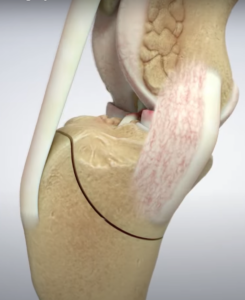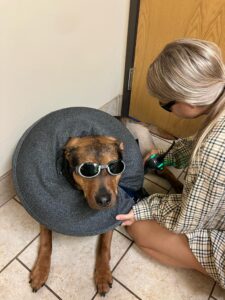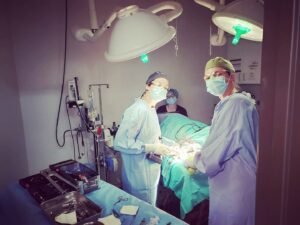What is a TPLO Surgery? Answers to the Most Commonly Asked Questions
Has your dog been limping? You may have noticed that your dog has a limp, but it’s here one day and gone the next, or you may notice they are limping all the time or they sit with one leg out to the side. Maybe they barely put any weight on one of their legs at all. You make an appointment with your veterinarian and find out your dog has CCL disease, and your dog will need a TPLO surgery to address it.
But what is a CCL? What is a TPLO surgery? Below, we’ll answer the most commonly asked questions to help you understand and make the best decision for your dog. But first, let’s start at where it all begins – with the CCL.
What is the CCL, and why is it important?
The Cranial Cruciate Ligament, or CCL, is a ligament in an animal’s knee that helps to keep the joint stable.
If we compare it to humans, it is similar to the ACL. The CCL has two main parts: a cranial and a caudal ligament. One of the ligaments goes from the back to the front of a dog’s knee, and the other from the front to the back. They cross in the middle, creating an “X.” Its job is to prevent the femur and the tibia from moving opposite each other when a dog walks. Since dogs have a natural bend to their knee when standing, this ligament is always in use.
What are the signs a dog may have CCL disease?
Some commonly seen signs are:
- Intermittent or persistent limping.
- Sitting with one leg out to the side.
- Not putting weight on the leg.
- Resistance to exercise.
- Leaning to one side while standing.
How does a dog injure its CCL?
Most often, it’s not just an injury.
CCL injuries are more of a degenerative disease process. It is often a degeneration over time that causes the ligament to break down. When it gets to the breaking point, a sharp turn, miss-step, or jump can cause the ligament to tear fully.
Does CCL disease affect all dogs?
No.
CCL disease has many factors. However, we do see it more commonly in larger breed dogs. Genetics and obesity are also a factor.
How painful is CCL disease for a dog?
Very painful; however, every dog reacts and shows pain differently.
In the early stages of CCL disease, when it’s usually only a partial tear, it will cause inflammation in the dog’s knee. At this point, the ligament is still doing its job. It’s the inflammation in the knee that causes pain. To help with the pain from this, rest and pain medication can often be started, which may help decrease the inflammation but is often a temporary fix. Your dog may return to normal and feel better, but if the tear is significant enough, the inflammation and pain will return, which can explain the intermittent lameness some dogs may show. Once the ligament fully tears, rest and pain medications are often no longer as helpful.
The meniscus can also be damaged during a tear, increasing some dogs’ pain. The meniscus is the shock absorber between the bones. Imagine when you have a rock in your shoe, and you can’t stop to shake it out, and it rolls around underneath your foot. It can get pretty uncomfortable, similar to what happens if cartilage becomes damaged and moves in the knee.
How does my veterinarian diagnose CCL disease?
With an initial exam and often sedated x-rays.
Your veterinarian will need a complete physical exam and a full set of diagnostic x-rays on your dog to diagnose CCL disease. The purpose of sedation is to keep your dog comfortable and to allow your veterinarian to do an exam without your dog protecting its leg. The leg must be in specific alignments on x-ray to obtain good images and get accurate measurements. At Buddy’s Vets, we start with a complete physical exam. If we determine that CCL disease is likely, we will schedule a sedated exam and x-rays.
* Please note that if your veterinary clinic does not offer TPLO Surgery and you get referred to Buddy’s Vets, we require repeat X-rays even if your veterinarian has already taken them. Repeat imaging is essential to ensure the proper measurements and calibration.
What is a TPLO surgery?
Tibial Plateau Leveling Osteotomy.
TPLO Surgery is where your veterinarian cuts the back part of the bone in a half circle and then rotates it a certain amount based on the x-rays. Once rotated, a titanium plate is applied on the inside of the bone to anchor it in place to allow it to heal.


Above photo(s) (screenshots) credits: CCL Tears and How a TPLO Surgery Works (youtube.com)
At Buddy’s Vets, this surgery is an outpatient procedure. Your pet will come in early in the morning and go home later in the day. For more information on orthopedic surgeries at Buddy’s Vets, you can read more in our blog Orthopedic Surgery for Your Pet: What You Need to Know.
You can also check out this YouTube video CCL Tears and How a TPLO Surgery Works (youtube.com) for a step-by-step look at TPLO surgery.
Is TPLO surgery painful?
Truthfully, yes.
As explained above, TPLO surgery involves cutting into bone and soft tissue. There will be pain with that; however, often, your dog is in less pain after surgery than before it.
At Buddy’s Vets, your dog’s comfort during and after surgery is one of our top concerns. Your dog will get proper pain control before, during, and after surgery based on their comfort level and pain assessment. In addition, we do a local block in the muscle and skin after surgery, which can last about three days. They also are sent home with oral pain medication as well.
Most of the time, your dog’s pain will lessen within the first 3-5 days after surgery. They will often limp for some time as the knee is still healing. Within the first week, they are often walking well on the leg. We’ve seen some truly remarkable things here with dogs post-TPLO surgery.
What is a TPLO surgery recovery like?
Recovery takes about 8-12 weeks.
The main concern is ensuring proper healing and recovery in the first 10-14 days after your dog is home from surgery. Within the first eight weeks, your dog should not run, jump, roughhouse, play, or go outside without a leash. Even if your pet has to go outside to the bathroom at 3 a.m. during a snowstorm, they must be on a leash. The last thing you want is for your dog to chase after a squirrel, cause extra strain on the plate, and break the hardware.
At Buddy’s Vets, we do not recommend strict crate resting for your dog post-surgery. It can cause muscle atrophy and delay the proper use of the leg over time. You should confine your dog to a smaller area. If your space does not allow you to keep your dog in a section or room, you can close all doors to narrow their space as much as possible.
Allowing your dog to move around the house within these restrictions is also essential. This movement can include getting up to drink or eat. It’s a delicate balance between restricting them enough so they can heal but not too much so they don’t get muscle atrophy.
At Buddy’s Vets, each dog will have the following post-operative rechecks:
- A follow-up exam with Dr. Harper 10-14 days after surgery. This exam ensures the incision is healing and your dog is doing well overall.
- To prevent licking and chewing of the incision and allow proper healing, we send your dog home with a lick sleeve (a tighter fitting sleeve secured around the waist). The lick sleeve can replace the need for dogs to wear an e-collar.
- Receive six laser treatments in the first three weeks after surgery. Laser treatments are every 4-5 days.

Every recovery protocol, including exercises, is designed with each dog and case in mind. Dr. Harper and her team will guide you through the process based on your dog’s recovery and comfort level.
* Please note that not all veterinary clinics offer the same recovery protocols.
What is the cost of TPLO?
Cost can vary.
We understand that cost is a concern for many pet owners. It is hard to provide an exact cost of any TPLO surgery. A wide range of variables play into the cost, including but not limited to where the procedure takes place, who is performing the surgery, and the events leading up to it. Your veterinarian can provide a more accurate estimate based on your dog’s case. At Buddy’s Vets, we will thoroughly review the price estimate for your dog’s TPLO surgery.
What if my dog doesn’t have surgery?
Not having TPLO surgery can have serious ramifications.
Surgery stabilizes the knee, which decreases the development of arthritis over time. If your dog doesn’t have TPLO surgery, over time, they will try to stabilize on their own and, in turn, develop significant arthritis in the process. Arthritis can severely decrease the quality of your dog’s life. Most dogs will become dependent on daily pain management, which can also be more challenging to control as they age as well.
Can’t my dog just wear a brace?
No.
Properly fitting a knee brace can be challenging. Additionally, your dog must always wear the brace to keep the knee stable, and it is never 100%. Wearing a brace can lead to other complications like infection and soreness. A properly fitted brace is often expensive and is not a proper fix for the injury.
Happy, Healthy Pets with a TPLO Surgery

If your dog needs TPLO surgery, we hope the information above has answered your questions and provided you with valuable information. The benefits of TPLO surgery far outweigh the risks. If your dog is limping or displaying any of the signs listed above, we urge you to contact us or your local veterinarian. Regarding your pet, CCL disease is nothing to joke about, and we here at Buddy’s Vets could not agree more.
